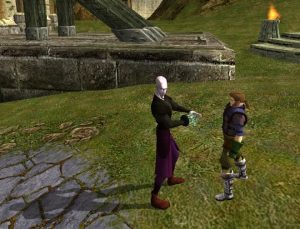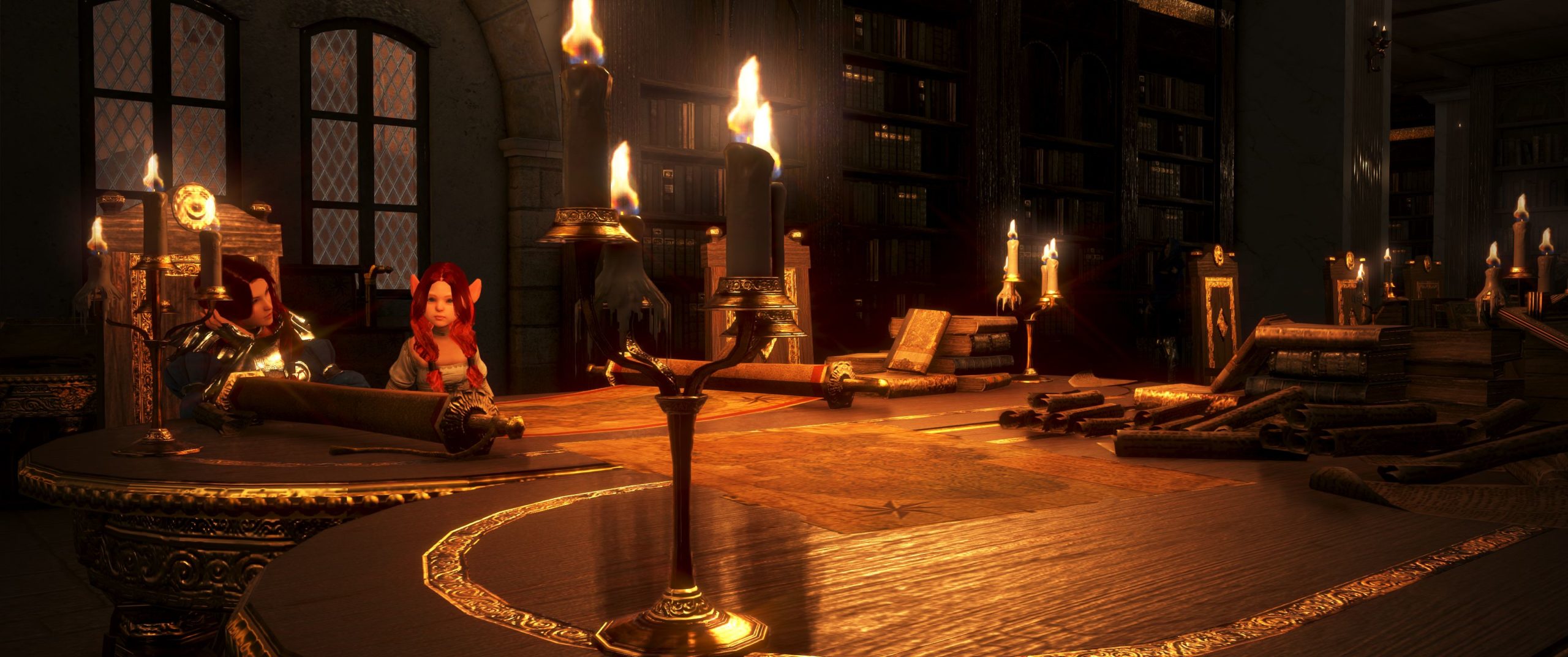
At GDC 2011, Raph Koster gave a talk in which he said, “Games are fundamentally social media and always have been.” You can watch starting at around 58:18 in the video from back then, and it’s admittedly a bit lofty. As a trained educator myself, I don’t agree that simply sharing information and knowledge is a game, as lectures rarely go well. In fact, I often have to make the sharing of information game-like by creating rules and structure that may not be real but creates enough stability that it’s easier to hold, like turning water into ice.
But as Koster starts off, he admits that about every other year, he goes off the rails and gives talks that may even include “erroneous” forecasting. 2011 may have been one of those years, and while I can’t exactly pinpoint when and where Koster may have toned this down and focused more on how other tech like ARGs are MMOs (not MMO-like), I do think it’s something worth discussing as we see more games going into the online-scene, ranging from clear online multiplayer (such as the recent addition to three-year-old local multiplayer game Super Mario Party) to those more fuzzy games like FarmVille or even recently released New Pokemon Snap. Heck, Wikipedia even as a page about itself as an MMO. There’s clearly a spectrum between MMO and non-game online tool, but what does it even look like?
Throughout the aforementioned arguments, Koster often briefly hints at the idea of social media as MMO: Both have avatars and player interaction environments that are persistent, and Koster’s even argued that “likes” are a form of currency, which can be “traded.” But often it feels more like these arguments are made in passing, a stepping stone to his larger points about digital marketplaces and the world slowly blurring the lines between game and reality. Some examples can feel like a bit of a reach, but Koster is typically giving these presentations as a kind of thought exercise meant to make us re-evaluate what we think we know, which was what led me to adopt the eight-point MMO-ness criteria I’ve been using to judge online games.
After reconsidering a few changes in the MMO sphere, like private servers for dead MMOs, I’m going to reorder them and slightly modify one item to put particular emphasis on the aspects I think are more saliently “MMO,” especially for MOP’s readers:
- Servers that don’t require or display a population size to start or cap out at. Lobby based games are disqualified if the lobby doesn’t meet the same criteria as the “core” part of the game.
- An in-game communication system that allows for conversation, not just reactions.
- Real-time interaction (for turn-based action, must be limited to seconds/minutes).
- Avatar-based (text, 2-D, 3-D, etc.).
- Environment is persistent and interactive.
- The environment then leads to player-to-player interaction.
- Must have AI to interact with as an integral part of the gameplay system.
- Must have some sort of reward system.
While I’ve previously discussed how and why the criteria is what it is, I think the first item should be addressed with some detail. One thing I think objectors often mean when they think they’re informing us that a game “isn’t an MMO” is that it doesn’t have enough concurrent players interacting in a single space. That being said, it’s also hard to peg down what is really “massive,” especially if we also wonder what’s the point of having all those players.
Look at a recent news update we had discussing the number of people who can play Scavengers, then look at the reader comments. Even with thousands of players, the question then comes down to what the players are doing and what the quality is. World of Warcraft’s arguably largest multiplayer PvE features are built for just 40 players max, significantly fewer than some MMORPGs that came before it, and yet WoW is still considered an industry standard.
Conversely, Asheron’s Call, which had interactive storylines based on anything from player “votes” to complex defense movements that involved a portion of the server leveling up a MOB until it required GM intervention to kill, is dead, and only a few titles are brave enough to attempt bringing back this kind of content, with some mixed results. AC still feels like the very definition of what the genre should be, but clearly it’s not what’s brought the genre into the mainstream, even among our own readers. Look no further than our 2020 Best MMO reader poll. Clearly readers believe more structured games have been performing well, and the game options from the industry support that.
This is why I’ve limited the criteria to servers that don’t publicly show caps. I’ve taken aim at lobby-based games, like in StarCraft or Monster Hunter games, because the “real” game is often very much different from the lobby. For example, while WoW has play-capped raids, it also has content in the rest of the game world that would fit the MMO criteria. The two can be divorced and still work. Conversely, Monster Hunter’s prep areas do not have reward systems for players who might choose to avoid the player-capped hunts. MH’s lobbies could be virtual worlds, but not games.
So now that we have some criteria, as well as examples of what we’d traditionally call an MMO and things that may seem MMO-like, I’d like to try to apply this criteria to Twitter, Venmo, and New Pokemon Snap and see how it holds up – and what that may mean about MMOs as a genre.
Applying the criteria
Let’s start with a more traditional type of social media for this. Given the past several years, Twitter’s gotten a lot more attention, and thus I would think even people who don’t use social media are probably familiar with the basics: Users have profiles, are able to publicly or privately send out messages/images/gifs, and can give out “Likes” or “Retweets” to promote/share information. Let’s go down the checklist now.
- Servers that don’t require or display a population size to start or cap out at. Lobby based games are disqualified if the lobby doesn’t meet the same criteria as the “core” part of the game
I’ve never heard of a lobby or user cap on Twitter, so that’s one MMO point for Twitter.
2. An in-game communication system that allows for conversation, not just reactions
It’s basically just communication, so yeah, that’s MMO point two for twitter.
3. Real-time interaction (for turn-based action, must be limited to seconds/minutes)
This is where things get fuzzy because Koster applies MMO-ness to things that most of us would argue are certainly not what we’d traditionally call games. Yes, the way one may construct themselves in polite society in order to progress through the social ladder to achieve wealth and status despite said actions going against one’s true beliefs is very much a game if you’re being objective about it. We naturally accept these rules because we’ve been “playing” our whole lives, and it’s only when someone who plays the game in a different region comes in and asks, “What’s up with that?” do we realize how arbitrary it is to choose whether it is more correct to lift your soup spoon to your face as to look polite, or whether to lift the bowl to one’s mouth and avoid the possibility of spillage that would certainly look bad and waste food.
So with this in mind, “turn-based” action would be conversational turns, in which, yes, Twitter’s interactions are real-time based. We’re on three MMO-points for Twitter now.
4. Avatar-based (text, 2-D, 3-D, etc.)
That’s a big yes, as Twitter gives you the ability to choose your name/handle and change it at will without needing to pay, and you can do the same with your avatar as well. You do have a unique account name that cannot be altered without creating a whole new account, but honestly, I think I’d prefer if more games actually allowed for this. That’s now four MMO-points for Twitter.
5. Environment is persistent and interactive
I’d say this is another big “yes,” but let me back this up a moment. We’re talking about the environment, not an avatar. So while your character in Monster Hunter is getting better gear, the environment is constantly being reset. Diablos can destroy every stone pillar in the level, but at the end of the hunt, those pillars go back up.
Tweets, though, last for years for the most part, and that’s without including sites keeping tabs on certain people’s tweet history, live or deleted. A tweet you made years ago can come back to haunt you, maybe even lead to employment termination if it’s particularly offensive to public tastes. They stay on your page and give an overall atmosphere or impression of you.
I’d argue these are not the same as your avatar as each tweet is a small ecosystem that attracts views, Likes, Retweets, and Comments that are separate from the way your Account as a whole is treated.
The fact that people can also reply, like, and share that message clearly shows it’s interactive. That’s now five MMO-points for Twitter. Is anyone else getting nervous?
6. The environment then leads to player-to-player interaction
No surprise, another “Yes” here. As I mentioned, each tweet becomes its own environment. New and separate conversations take off, not even necessarily directly involving the original “player” but just a fraction of the content they’ve shared. That’s now six MMO-points for Twitter.
 7. Must have AI to interact with as an integral part of the gameplay system
7. Must have AI to interact with as an integral part of the gameplay system
While there are bots on Twitter, those are often “player-run.” A “single-player Twitter” would be quite dull, as would a five-player Twitter. There are automated systems to help Twitter sort through the muck, but I’d argue that they’re minimal, which is why human moderators are required.
The one area that feels fuzzy is the recommendation algorithm. It could be a kind of “Group Finder” system, as the recommendations should give you a space to discuss things relevant to your interest. It could also work as a kind of quest system, as interacting in those areas would give you ways to earn likes.
However, ad blockers remove some of the “content,” which reminds me that this is part of the monetization. While a game needs funding, it should be able to function without its monetization system. That is, if we were to run Twitter on a private server, then leaving out the monetization system, like recurring subs, shouldn’t affect core gameplay. Similarly, if Twitter’s algorithm were to suddenly be non-functional, we could still use Twitter in almost the same way. For this reason, Twitter does not meet the requirements for point 7.
8. Must have some sort of reward system
Likes act as a reward, even if it’s just warm fuzzies. Views, replies, and retweets could count as well, so we’ll give Twitter the MMO-point, giving Twitter score of 7/8.
Compared to other, more traditional games I’ve used this system on in earlier forms, Twitter surprisingly hits a lot of those MMO notes, particularly the one about the lack of playerbase caps. You can have millions of “players” interacting within a tweet at any one time, so it’s more multiplayer than Monster Hunter and more “massive” than World of Warcraft.
 Briefly going through payment service system Venmo reveals it is actually quite similar MMOness as Twitter with a score of 7/8, also tripping up on item 7, as it has no real AI interaction, just simple chat and payment systems. Conversely, New Pokemon Snap, which is clearly a video game, fails on criteria 1 (the online rating system is more of a kind of lobby that cannot stand without the single-player aspect) and likewise fails criteria 2’s communication requirements.
Briefly going through payment service system Venmo reveals it is actually quite similar MMOness as Twitter with a score of 7/8, also tripping up on item 7, as it has no real AI interaction, just simple chat and payment systems. Conversely, New Pokemon Snap, which is clearly a video game, fails on criteria 1 (the online rating system is more of a kind of lobby that cannot stand without the single-player aspect) and likewise fails criteria 2’s communication requirements.
What this means is that you cannot simply say an MMO is any online game with lots of players. As entertaining as this may be as a kind of thought exercise, if you tell someone your main MMO is Twitter, people will look at you sideways. I’d argue replacing Pokemon Snap would give a similar reaction, but perhaps less so as it’s more identifiable as a “game,” and MH would be less problematic but still feel more on-point.
To me, this indicates that an MMO scoring system inherently would have the criteria I’ve outlined at the least, but each criteria would need to have points assigned to it. As criteria 1 is perhaps the most identifiable for the genre, it could be worth 10 points. Criteria 8, rewards, might be viewed as still critical to the genre, but as over-tuned rewards leading to financial gain in the real world might threaten that virtual world, we may only want its points limited to 1 because it could be argued that at a certain point, financial gains through gaming then becomes work, not a game.
Again, there’s clearly an MMO-spectrum. I think it’s a disservice to both games and MMOs to simply write off a product as “not an MMO” based on one criteria without understanding how various mechanics can make a game feel more or less MMO-y. Determining those criteria has felt difficult enough, not just today but in past reviews. I’d dare say it may be something the MMO community grapples with, as our recent discussion about loot being the “soul” of an MMO had most of our staff and readers questioning that, yet I think the average person who sees useable combat or avatar-related pixels as an action-reward makes that virtual realm more of a game than one that rewards effort with a simple thumbs-up with a number next to it.
Determining the weight of each criteria we use in assessing what is or is not an MMO is a whole other issue. My question, though, is that do you readers have thoughts on how each of those criteria points should be weighted? Or does it feel like noting how a game does or does not meet that criteria enough to help get a sense of a product’s MMO-ness?
 Everyone has opinions, and The Soapbox is how we indulge ours. Join the Massively OP writers as we take turns atop our very own soapbox to deliver unfettered editorials a bit outside our normal purviews (and not necessarily shared across the staff). Think we’re spot on — or out of our minds? Let us know in the comments!
Everyone has opinions, and The Soapbox is how we indulge ours. Join the Massively OP writers as we take turns atop our very own soapbox to deliver unfettered editorials a bit outside our normal purviews (and not necessarily shared across the staff). Think we’re spot on — or out of our minds? Let us know in the comments!


















